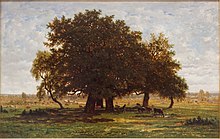Paysage intimate

The oaks of Apremont , painting by Théodore Rousseau , 1852

Landscape in the Dachau Moos , painting by Philipp Röth , 1895
The paysage intime ( French for "familiar landscape") was a style of painting that dealt with plain, simple landscape images and was created in the mid-19th century. It was the predecessor of the Impressionist style .
This style was a specialty of a French group of artists. Her relatives met in the small French village of Barbizon . The pictures do not convey any historical or religious content, they are rather uncomplicated extracts of nature from the artist's point of view, sometimes in a slightly romantic way. The paysage intime laid the foundation for Impressionism.
In Germany, Paul Weber and Philipp Röth representative of this style.
See also
literature
- Walther Gensel: The masters of the “paysage intime” . In: The art. Monthly books for free and applied arts , Vol. 9 (1904), pp. 225–238, pp. 251–258 and pp. 275–280.
- Vera Meyer-Huber: The development of the “paysage intime” in Swiss landscape painting of the 19th century . Conzett & Huber, Zurich 1946 (also dissertation, University of Zurich 1946).